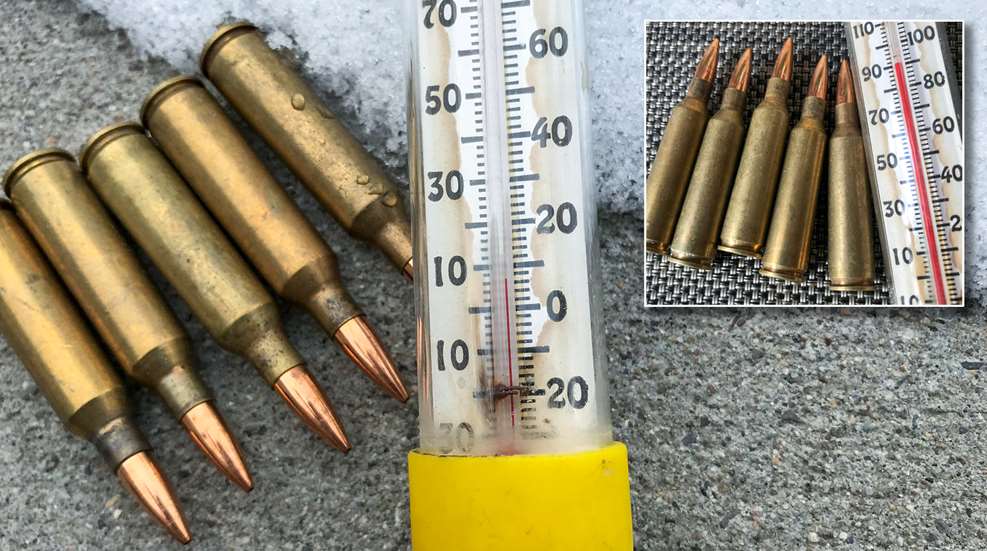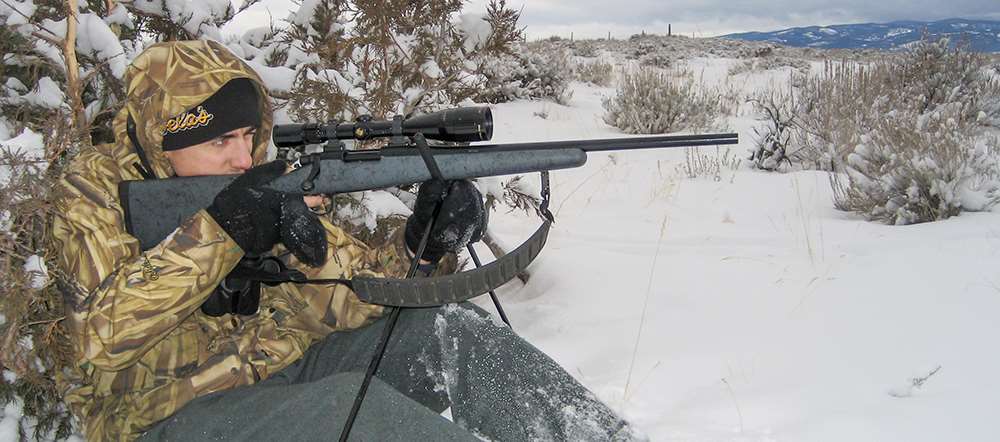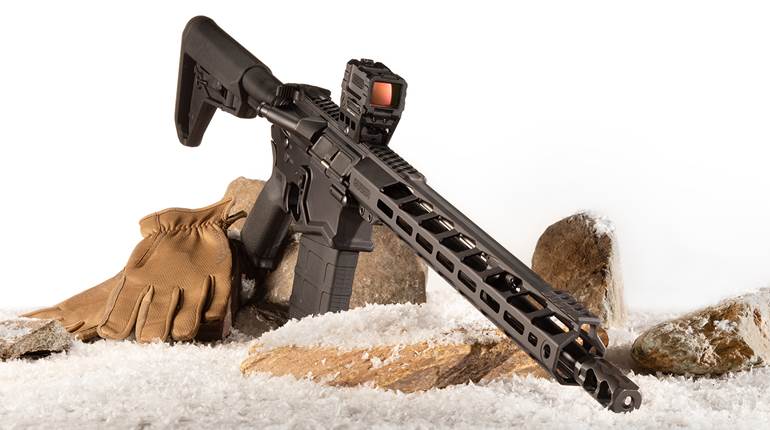
Velocities can suffer when the mercury drops. Certain propellants, though, can keep velocities even across wide swings in temperature. When the thermometer heat ups, propellants tend to launch bullets at somewhat faster speeds than during cold temperatures.
Years ago, hunters rarely considered that the propellant they handloaded into their rifle cartridges could cause enough of a swing in velocity between shooting during the summer heat and the winter cold that it might cause them to miss their targets and/or game at extended distances. Today, though, many propellants are explicitly advertised as being insensitive to temperature changes, having been designed to produce uniform velocities, no matter the weather.
Hodgdon introduced its Extreme Extruded propellants in 1996, including Benchmark, Varget, H322, H4198, H4350, H4831SC and H1000. IMR followed with its Enduron Technology propellants in 2015 that comprise IMR 4166, 4451, 4955, 7977 and 8133. Alliant Powder incorporates TZ Technology into its Reloder TS 15.5, 16, 23 and AR Comp propellants that “manipulates the response of the material and resists the natural tendency to generate more pressure at higher temperatures and less pressure at lower temperatures.” Alliant states that other Reloder propellants, such as 15, 17 and 26, also produce consistent velocities across temperature extremes.

The Ramshot website states that most of its propellants are “not insensitive and will show some effect at hot and cold temperatures.” Ramshot has tested its propellants at -40° F and 125° F, and the deviation in most cases is about 3 to 5 percent at those extreme levels. Ramshot advises that complete temperature stability is only achieved with tubular, extruded propellants, either with double-base nitroglycerin and/or with other coating technologies.
But ballistic performance at extreme temperatures is also dependent on the specific combination of cartridge and bullet weight. “If any of these parameters/aspects go beyond or outside the intended ratios, the results will change and the performance will sometimes be different,” Ramshot states.
To go about testing temperature-insensitive powders, I handloaded batches of three different rifle cartridges, each with a particular bullet paired with one propellant considered to be resistant and one propellant not considered resistant to temperature extremes. For instance, a .22-250 Rem. was loaded with Berger 64-grain FB Varmint bullets and Varget, which is a Hodgdon Extreme Extruded propellant, and IMR 4064, which is not.
To keep each of the loads as identical as possible, each cartridge was loaded from the same sleeve of primers and lot of cases. The different propellants were dispensed through an RCBS MatchMaster Propellant Dispenser that doled out propellant weights within +/-0.04 of a grain of precision.

I fired the first set of cartridges on an afternoon last summer when a thermometer registered 94° F in the shade. Cartridges sat in the sun only long enough to shoot each batch. Leaving cartridges to bake in the sun for an hour or so would have raised their temperatures enough to make them too hot to handle. However, I don’t leave ammo on the dash of my pickup and do my best to keep cartridges (and myself) in the shade on summer days while shooting ground squirrels or targets.
The summer shooting went smoothly. A Remington Model 700 SPS chambered in .223 Rem. and a Cooper Model 22 chambered in .22-250 shot five-shot groups of less than an inch at 100 yards with both their loads. A 6 mm Creedmoor-chambered Ruger American Predator was close behind, shooting groups a bit larger than an inch.
Looking over the chronograph results, though, the extreme spread of velocity was rather excessive for several loads. For instance, the extreme spread of velocity was 68 f.p.s. over five shots for the .223 loaded with Nosler 50-grain Ballistic Tips and 28.5 grains of CFE 223 propellant. In comparison, the same bullet fired with 26.5 grains of Benchmark registered a much lower 32 f.p.s. of extreme spread. Worst was a 132 f.p.s. extreme spread for Berger 64-grain FB Varmint bullets fired with IMR 4064 from the .22-250. That velocity spread translates into 7" of difference in trajectory at 600 yards between the fastest and slowest bullets.
Cold air pressing in from the north drops temperatures here well below zero on winter days, with sunny and clear skies blue as glacial ice. Years ago, when I was young and impervious to the cold, I thought -20° F made for a perfect hunting day because coyotes and red fox could hear the squeals from my mouth call mimicking a dying rabbit from a mile through the still air. The dead-calm air also meant not having to compensate for wind drift when a coyote or fox stopped far out, suspicious of a purported free meal.
Through the years, however, I’ve softened. On such cold days, I’d rather build a fire and stand close or stay inside and look longingly out the window. Zero on the thermometer is about the dividing line of when I can still sit in a snowbank for half an hour or so at a time and actually have fun. When the thermometer registered near zero this past winter, I headed back to the range to shoot the rest of the .223, .22-250 and 6 mm loads.
Through the Remington .223, the Benchmark load fired Nosler 50-grain Ballistic Tips 77 f.p.s. slower at 8 degrees than it had at 94 degrees. Extreme spread of velocity increased to 56 f.p.s., compared to the 32-f.p.s. spread recorded at 94 degrees. CFE 223, not considered to be temperature-resistant, lost less velocity at 51 f.p.s. Extreme spread of velocity also narrowed some to 56 f.p.s., compared to 68 f.p.s. shot during the summer heat. This isn’t unexpected, as the “223” in the propellant’s name suggests it was developed primarily for use with the .223 Rem. Point of impact of the Ballistic Tips, with both propellants, shot in the cold was about 0.2" lower than when shot during the summer.
The Cooper Model 22’s .22-250 bull barrel tapers only slightly over its 24" length. Groups shot with Berger 64-grain fired with Varget and IMR 4064 also landed about 0.2" lower during the cold weather compared to the warm weather.
Berger bullets lost 93 f.p.s. of velocity shot with IMR 4064 in the cold, compared to summer shooting. Extreme spread of velocity remained high. The Varget load lost only 41 f.p.s. from summer to winter shooting. That was more than satisfactory, and extreme spread of velocity was slightly less than that.

Varget performed nearly as well when shooting Hornady 75-grain V-Max bullets from the 6 mm Creedmoor. The V-Max bullets slowed 76 f.p.s., compared to the heat of summer. Velocity loss was higher, at 97 f.p.s., shooting Big Game. The size of hot and cold five-shot groups varied only slightly with both propellants.
That bullet speed loss of 97 f.p.s. for Big Game propellant would result in only 3" of additional drop at 500 yards than the load shot during the summer heat. However, we must also consider that trajectory is influenced by air density, which is thicker at 8 degrees than it is at 94 degrees. The V-Max plowing its way through the cold air resulted in about an additional 2" of drop at 500 yards—so it seems something always plagues an exact bullet flight.
Still, bullet velocities can be kept fairly constant to minimize trajectory differences by testing your loads at the same temperatures that you plan to shoot them and by picking a propellant that produces uniform velocities, regardless of the weather.





































